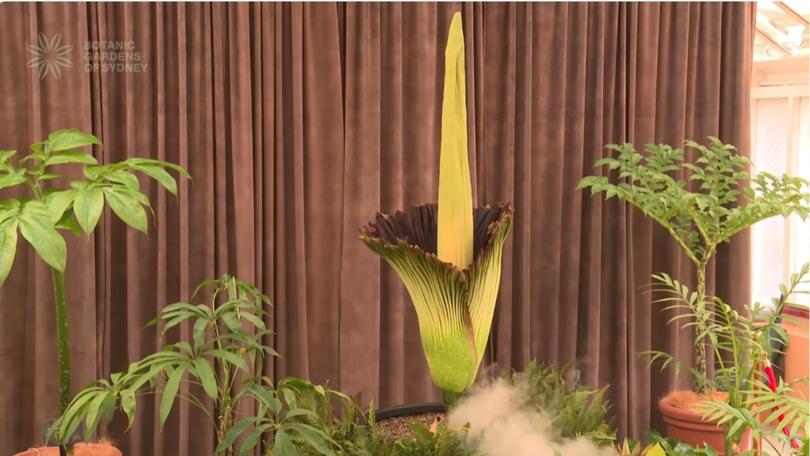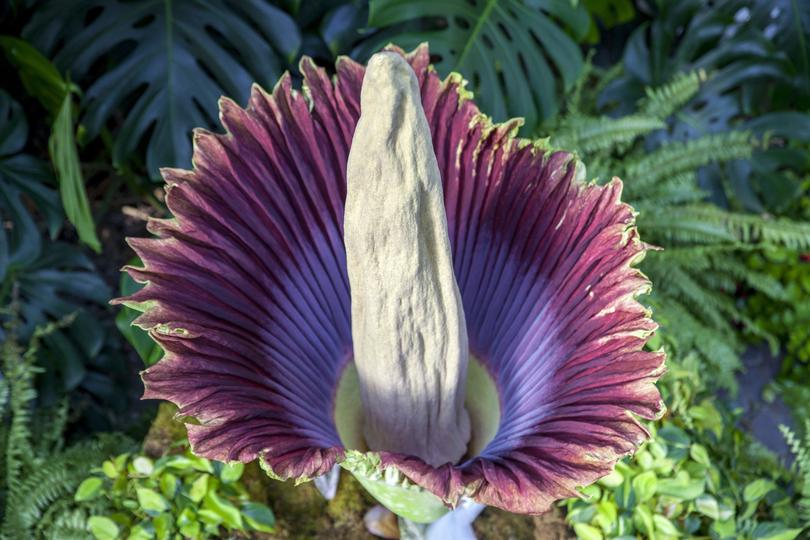Putricia: Sydney’s blooming corpse flower draws thousands of fans to bow down to the ‘stink queen’

A new It-girl is blooming in Sydney — literally — and thousands of fans are glued to a live stream to bear witness her once-in-a-generation reveal.
The Botanic Gardens of Sydney has glued thousands of viewers to its YouTube channel to watch a corpse flower unfurl its petals for the first time in years. The bloom, once it starts, will take between 24 and 48-hours to complete.
To the scientific community, the flower is known as amorphophallus titanum — which translates to large, deformed penis — or Bunga Bangkai.
Sign up to The Nightly's newsletters.
Get the first look at the digital newspaper, curated daily stories and breaking headlines delivered to your inbox.
By continuing you agree to our Terms and Privacy Policy.To the Botanic Gardens staff and the thousands of people who have swarmed to worship the “stink queen”, the endangered plant is known as Putricia.
Putricia — a hybrid of “putrid” and “Patricia” in honour of the foul smell she will emit when fully bloomed — has been on display in front of a curtain at the Gardens’ greenhouse since Friday.
She has attracted a rolling queue of visitors each day eager to see her slowly unfurl; the live stream has attracted thousands of viewers each day. On Thursday afternoon, more than 8000 people were watching their beloved “stink queen”.
“All hail Putricia,” one person wrote in the stream chat.
“Putricia for president,” another wrote, while another declared: “Putricia for Aussie Queen.”
A team of botanists have been monitoring Putricia, taking photos of her unfolding blossom and monitoring her temperature.
Although the Gardens have several Bunga Bangkai in thier greenhouse, to see one in bloom is a truly rare event.
“We’re super excited here because we haven’t had a corpse flower bloom in over 15 years,” Sophie Daniel, Manager of Interpretation & Placemaking at the Botanic Gardens of Sydney said in a video on Instagram.
“Putricia is astounding. She is glorious, she is stunning.”
The Gardens predicted Putricia would bloom between Saturday, January 8 and Monday, January 20 — which means, like the diva she is, she’s fashionably late.
“A few days ago horticulturalists working in the glasshouse noticed the initial clues that one might be entering the flowering stage,” the RBG said in a statement last week.
“Daily measurements and close observation began, and due to vital information sharing from other botanic gardens across the world about Amorphophallus titanium blooming patterns, the team can now confirm that we are likely to have a stinky inflorescence in the next few days”.
The corpse flower is renowned for the truly heinous odour it emits when in bloom, one likened to that of a rotting carcass.
“If you’ve ever driven by a three day dead roo on the side of the road, on a hot summers day, she will smell similar,” one commenter wrote on the livestream.

But it’s all for a purpose: to attract carrion-eating beetles and flesh flies to pollinate the two rings of flowers flowers within the spathe — the large petal-like form wrapped around the tall spike-like structure, the spadix, reaching out of the plant.
The upper ring of flowers around the spadix are male, while the lower ring is dotted with bright red-orange female flowers — a colour that imitates the rotting meat it smells of to trick the insects into landing.
The female flowers open first, then the males a day or two later which is a means of preventing the flower of self-pollinating.
The smell they emit can be detected by insects more than a kilometre away.
The flower will remain on display until midnight on bloom day. Entry to see Putricia at the Royal Botanic Garden in Sydney is by donation.
But if you have a sensitive constitution and would rather watch it unfurl from home, you can watch the live stream on YouTube.
